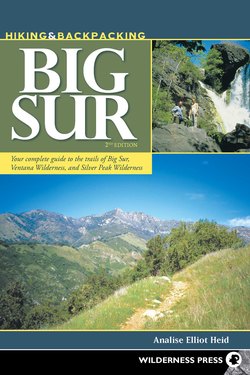Читать книгу Hiking and Backpacking Big Sur - Analise Elliot Heid - Страница 9
На сайте Литреса книга снята с продажи.
ОглавлениеCHAPTER one
Introducing Big Sur
BIG SUR. THE NAME EVOKES IMAGES of a wild and rugged coast. In the mid-1800s, a handful of independent and adventurous homesteaders, fur traders, ranchers, and entrepreneurs settled the area along steep, narrow wagon roads. But Big Sur would remain remote until Highway 1 was completed in 1938. Modern-day visitors are struck by the drama of this two-lane roller coaster, which twists and winds through blankets of fog along sheer cliffs hundreds of feet above the Pacific.
Just where Big Sur begins and ends has long been a matter of debate. Historically, early Spanish explorers named the vague unexplored wilderness south of Monterey El Sur Grande (“The Big South”). Today, the region encompasses a 90-mile coastal stretch between Carmel to the north and San Simeon to the south, flanked on one side by the high peaks of the Santa Lucia Range and on the other by the jagged coast and broad Pacific Ocean.
While Big Sur is widely renowned for its exceptional beauty, few people venture beyond Highway 1. In addition, few roads cross the Santa Lucia Range, making it one of the largest roadless areas along the continental US coast. The result? A vast, remote wilderness waits to be explored.
About This Book
IN THIS BOOK, trips in Big Sur country are described in two parts: Part I, State & Federal Lands of the Big Sur Coast, and Part II, Ventana & Silver Peak Wildernesses.
Trips in Part I list day hikes only, as state and federal lands are limited to day use. While some state parks offer campgrounds, backcountry camping is forbidden. In contrast, the wilderness areas described in Part II offer more than 300 miles of trails and restricted roads to explore on either day hikes or extended backpacking treks. Each part is subdivided into chapters that list trips in geographic order from north to south.
Each trip includes summary information and the hike description itself.
Summary
Summary information for each trip includes:
TITLE The highlighted destination(s) along the route.
LENGTH AND TYPE The overall length of the hike and whether the route is out-and-back, point-to-point, or a loop. Distances to specific waypoints are listed in each hike description.
RATING This book rates each trip according to physical effort and ease of access. Ratings are as follows:
Easy: Typically a short hike on level terrain with less than 500 feet of total elevation gain.
Moderate: Hikes with a consistent medium grade with roughly 500–1000 feet of total elevation gain.
Strenuous: Typically longer hikes with approximately 1000–2000 feet of elevation gain.
Challenging: A very strenuous hike with roughly 2000–3000 feet of total elevation gain over many miles of steep, rugged trails in often remote regions. Wilderness experience and ethics required.
TRAIL CONDITION Many routes within the wilderness areas are ill maintained, suffering from landslides, encroaching brush, and vanishing tread. The five-level rating system described below summarizes the general navigability of the trail. This section also advises whether the trail is good for kids, and whether you’re likely to encounter poison oak.
Well maintained: Typically heavily used and regularly maintained.
Clear: A well-defined trail with no major obstructions.
Passable: The trail is evident with some encroaching brush and/or downed debris. Lightly traveled and not regularly maintained.
Difficult: The trail is faint with waist-high or above brush and/or fallen debris.
Impassable: The trail is unrecognizable with major trail obstructions, including encroaching brush, landslides, and/or much fallen debris.
HIGHLIGHTS The natural feature(s) that distinguish each hike.
TO REACH THE TRAILHEAD Concise directions to the start of the trail. Where necessary, information is provided regarding facilities, water, entrance fees, and parking fees.
TRIP SUMMARY A basic description of the route, including any day hike or extended overnight options. Includes information on potential difficulties/hazards, as well as advice on the best time of year to visit.
Maps
Each trip is shown on a map, which is placed adjacent to the trip itself or adjacent to a nearby trip. Please see the map legend for details about the maps.
Trip Description
Each trip description offers a thorough breakdown of the route, including trail conditions, seasonal considerations, water sources, historical notes, geology, plant and animal life, etc. Directions include all trail and spur junctions, camps, natural landmarks, and other notable features. Camps, junctions, and certain key features are listed in bold type followed by a parenthetical notation of the distance from the trailhead in miles and elevation in feet—for example, Hiding Canyon Camp (5.5 miles, 2500').
In certain instances, trail descriptions may overlap from one trip to the next. In such cases, the reader might be directed to a previous description for the route up to a certain point—for example, “See TRIP 49 Pine Valley for the first 5.3 miles of this route to Pine Valley.”
If a spur leads to a notable feature (e.g., a camp, swimming hole, etc.), the trip description may include a Side Trip that elaborates on that feature. You’ll also find sidebars throughout the text that offer more detail about natural features, historical anecdotes, and the like.
Tectonic activity created the prominent peaks and ridges of the Santa Lucia Range.
